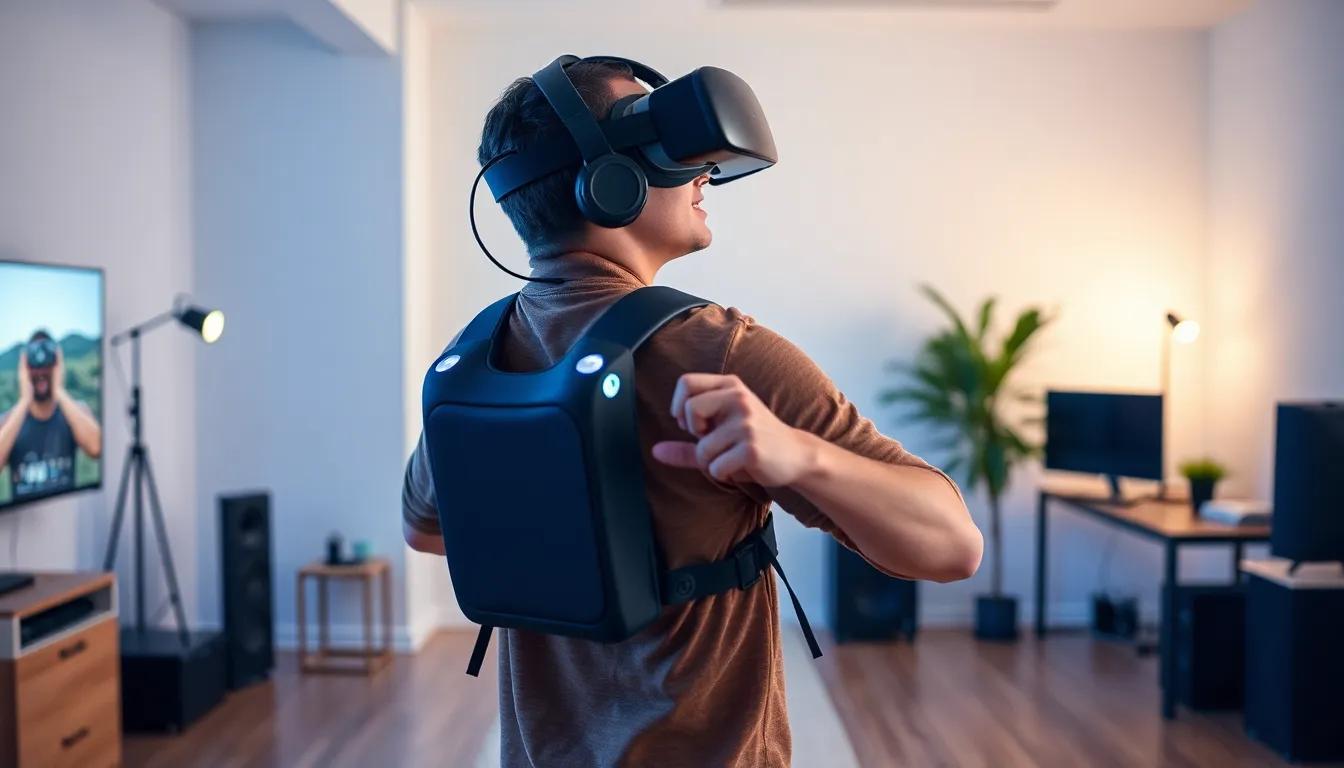Virtual reality is reshaping the way people experience gaming and immersive environments. At the forefront of this revolution is the VR backpack PC, a game-changing device that liberates users from the constraints of traditional gaming setups. With its portable design, it allows for a fully immersive experience without the hassle of tangled wires or limited movement.
These innovative machines combine powerful hardware with the freedom of mobility, making them ideal for both gaming enthusiasts and professionals in various fields. As VR technology continues to evolve, the demand for backpack PCs is surging, promising a future where users can explore virtual worlds with unparalleled ease and creativity.
Table of Contents
ToggleOverview of VR Backpack PCs
VR backpack PCs represent a significant advancement in virtual reality technology. These devices combine powerful computing hardware in a portable form factor, allowing users to engage with immersive environments while remaining untethered. Unlike traditional VR setups, which often rely on cables connected to a stationary computer, a backpack PC enables true freedom of movement.
Key components of VR backpack PCs typically include high-performance CPUs and GPUs, substantial RAM, and large storage capacities. Many models support advanced graphics settings and deliver high frame rates, enhancing the overall gaming experience. The integration of efficient cooling systems ensures optimal performance during extended use, which is crucial for immersive applications.
Users benefit from multiple connectivity options such as HDMI, USB-C, and Ethernet ports, allowing the integration of various VR accessories and peripherals. Built-in batteries provide extended usage times, making these devices ideal for both entertainment and professional applications like training simulations or architectural visualizations.
The growing popularity of VR backpack PCs aligns with the increasing interest in VR gaming and applications across various industries. As technology continues to advance, these systems are expected to evolve, featuring improved processing power, lightweight designs, and longer battery life options.
Key Features of VR Backpack PCs

VR backpack PCs feature impressive specifications and unique designs tailored for immersive experiences. These devices provide the freedom of movement essential for virtual reality applications.
Performance Specifications
Performance specifications define the capabilities of VR backpack PCs. Most models incorporate high-performance CPUs, such as Intel Core i7 or i9 processors, ensuring efficient processing for complex applications. Graphics capabilities are equally essential, typically supported by powerful GPUs like NVIDIA RTX 30 series, delivering high frame rates and stunning visuals.
Memory capacity often reaches 16GB or more of RAM, granting sufficient multitasking capabilities during resource-intensive sessions. Storage options frequently include SSDs ranging from 512GB to 2TB, offering fast load times and ample space for games and applications. Efficient cooling systems, like vapor chamber technology, maintain optimal temperatures, preventing overheating during long usage periods.
Portability and Design
Portability and design enhance user experience in VR backpack PCs. Weighing between 8 to 12 pounds, these devices balance powerful performance with relative ease of transport. The ergonomic design commonly features adjustable straps and lightweight materials, ensuring comfortable wear during extended use.
Most models include a detachable battery system, providing 1.5 to 3 hours of continuous operation and making it easier to recharge while in use. The compact form factor often integrates a rugged chassis, ensuring durability without compromising aesthetics. This thoughtful engineering allows users to move freely in virtual environments while enjoying top-tier performance.
Popular Models on the Market
Several models of VR backpack PCs dominate the current market, providing an array of features and specifications tailored to different user needs. Below are selected models that exemplify the capabilities and performance of this innovative technology.
Model Comparison
| Model | Weight (lbs) | Processor | GPU | RAM | Storage | Battery Life (hours) | Price Range |
|---|---|---|---|---|---|---|---|
| HP Omen X | 10 | Intel Core i7 | NVIDIA RTX 3070 | 16GB | 1TB SSD | 2 | $2,500 – $3,000 |
| MSI VR One | 8 | Intel Core i7 | NVIDIA GTX 1070 | 16GB | 512GB SSD | 1.5 | $1,800 – $2,200 |
| Zotac VR Go | 7.5 | Intel Core i7 | NVIDIA GTX 1060 | 16GB | 1TB HDD | 2 | $1,500 – $1,800 |
| ASUS ROG Strix XG Mobile | 9 | Intel Core i9 | NVIDIA RTX 3060 | 32GB | 1TB SSD | 3 | $3,000 – $3,500 |
User Reviews and Feedback
User reviews consistently highlight key traits of popular VR backpack PCs. Performance ratings often receive high marks due to robust processing power and minimal latency. Users appreciate ergonomic designs, which facilitate extended play without discomfort. Battery life factors prominently in reviews, as models providing over two hours of operation receive favorable feedback. Additionally, many users express satisfaction with the ease of setup and portability, emphasizing the convenience offered by detachable battery systems and lightweight designs. However, some users note the high price point as a drawback, highlighting the need for budget-friendly alternatives in the VR backpack market.
Applications of VR Backpack PCs
VR backpack PCs serve a variety of purposes across different fields, enhancing both recreational and professional experiences. Their unique design and powerful specifications cater to the needs of gamers and industry professionals alike.
Gaming Experiences
Gaming experiences benefit immensely from VR backpack PCs. These devices eliminate cumbersome cables, allowing players to move freely and interact dynamically within virtual worlds. Players enjoy immersive graphics and high frame rates, made possible by top-tier components like Intel Core i7 or i9 processors paired with NVIDIA RTX 30 series GPUs. Titles such as “Half-Life: Alyx” and “Beat Saber” showcase the potential for rich, interactive environments, enhancing player immersion. Multiplayer experiences also thrive as users can collaborate or compete in expansive virtual spaces without restrictions.
Professional Use Cases
Professional use cases of VR backpack PCs extend across various industries, from training simulations to virtual meetings. In fields like architecture and engineering, professionals utilize these devices to visualize 3D models in real-time, improving design accuracy and client presentations. Medical professionals leverage VR backpack PCs for realistic simulations in surgical training, allowing practitioners to hone skills without risk. Additionally, corporate environments use these devices for immersive training and collaborative brainstorming sessions, fostering engagement and creativity. The versatility of VR backpack PCs enables a seamless transition from gaming to professional applications, showcasing their value in diverse settings.
Future of VR Backpack PCs
Advancements in VR backpack PC technology indicate a promising future for enhanced virtual experiences. Expectations include substantial improvements in processing power. Emerging models are likely to feature next-generation CPUs and GPUs, further elevating graphics capabilities and processing efficiency.
Weight reduction in future designs remains a crucial factor. Innovations in materials and engineering techniques may lead to lighter models, enhancing portability without compromising performance. Incorporating advanced battery technology could extend operating times significantly. Future devices may offer rechargeable batteries with capacities exceeding 3 hours, catering to users’ needs for extended immersion.
Enhanced connectivity is another area of focus. Improved wireless technologies, including 5G and Wi-Fi 6, may allow for faster data transfer, resulting in smoother experiences with lower latencies. This can facilitate seamless multiplayer interactions in gaming environments or real-time collaboration in professional applications.
Moreover, the potential for customizable configurations could attract a wider audience. Users may choose specific components based on their needs, whether in gaming or professional scenarios. This adaptability could make VR backpack PCs more appealing to a broader range of consumers.
Integration with AI and machine learning technologies shows potential for improving performance optimally based on user behavior. By analyzing usage patterns, future VR backpack PCs might adjust settings, providing a tailored experience that maximizes efficiency and enjoyment.
Diverse applications across industries will likely expand. Beyond gaming, fields such as education, training, and healthcare may increasingly adopt VR backpack PCs for simulations and interactive learning. As safe, immersive environments become integral to these sectors, the demand for VR backpack PCs may rise significantly.
The future of VR backpack PCs promises innovation across multiple dimensions, including performance, design, connectivity, and application. Manufacturers are poised to meet these evolving demands, solidifying the role of VR backpack PCs as essential tools in immersive experiences.
The VR backpack PC represents a significant leap in how users engage with virtual environments. Its portability and high-performance capabilities allow for unparalleled freedom of movement, enhancing both gaming and professional experiences. As technology continues to evolve, the potential for these devices to transform various industries is immense.
With advancements in processing power and battery life on the horizon, the future of VR backpack PCs looks bright. They’re not just tools for gamers; they’re becoming essential in fields like training and education. As the market grows, users can expect more options that cater to different budgets and needs, making immersive virtual experiences accessible to a wider audience.


